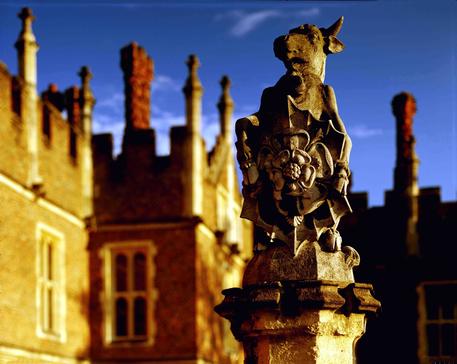
Photograph copyright ©1999 - 2018 Denis Waugh.
External Links
HAMPTON COURT
The building of the palace of Hampton Court, just 14 miles from Westminster, was begun in 1515 by Cardinal Wolsey. Wolsey had bought the site from the Order of St John of Jerusalem the year before he became Cardinal and Lord Chancellor of England. With 280 rooms for guests and a staff of over five hundred, the hospitality offered by Wolsey was the wonder of Europe and Henry VIII so envied its splendid architecture and fittings that Wolsey made it over to him in 1526. But the gift was not enough to save him from execution in 1530.
Henry was a keen gardener and a huntsman and he took a personal interest in laying out the gardens and stocking the park with game. Hampton Court was where his beloved third wife, Jane Seymour died, having given birth to Edward IV, and where Edward spent most of his short existence, the clean air and the pure water perhaps extending his life a little. His sister Mary received her proposal of marriage here from the awful Philip II of Spain and after her marriage returned through these gates to spend most of her honeymoon and the four lonely years of her reign here, waiting in vain through false pregnancies and bitter recriminations for the baby that never came.
Elizabeth came to live here the year after her accession to the throne in 1559. She, too, was a keen gardener, enjoying the nitty-gritty of digging and planting - but only when unobserved. In company, `She, who was the very image of majesty and magnificence, went slowly and marched with leisure.' One is reminded of a description by a contemporary at Windsor Castle who remarked on the Queen's perambulations on the battlements - but only in calm weather. She had a detestation of wind, probably as well as ruffling the royal composure it unsettled the royal wig.
Charles I dug the wide channel, 11 miles long, for bringing water to the ornamental lakes and fountains he designed in the gardens, and brought some four hundred fine paintings (including nine Mantegnas) as well as sculptures, ivories, crystal and porcelain to adorn the living quarters.
Here is some of finest Tudor architecture in Britain and, sadly, for its preservation we have to thank the untimely death of Queen Mary of smallpox in 1694. Mary's marriage to William, Prince of Orange, was a political one: Charles II having no legitimate children meant that her father, James Duke of York was the heir to the throne, and after him came Mary, the eldest of his two daughters. The religion of James was suspect, however: although he was not overtly Catholic, it was widely known that it was with Rome that his heart belonged. So, with the paranoia and terrorism associated with the so-called Popish Plot, it was expedient that the pretty fifteen-year-old Princess Mary should be allied with the state of Orange, perceived as a brave anchor of Protestantism in Europe. Never mind that her cousin, her appointed bridegroom, was ten years older, physically weak with a tendency to a hunchback and taciturn to a degree - not unlike his great-grandfather, William the Silent. Yet William and Mary were happy together and in 1688, a bloodless coup was executed when they landed in England and, James II having fled abroad for his life, were jointly offered the throne.
William and Mary reigned in tandem for only six years, and during their tenure of Hampton Court Henry VIII's state departments were demolished, it being the intention of their chosen architect, Sir Christopher Wren to built a new Versailles. Between 1696 and 1704 Wren was busy rebuilding and extending the palace, with constant advice and encouragement from Mary, whose judgement and taste Wren termed `exquisite'. Well, it would be, with her Stuart ancestry. But the point is that after her death William lost heart somewhat and the plans for the great new palace were somewhat curtailed.
Which is nice for us, because from different façades we have two very different palaces, both of which, for their type, are quite simply unsurpassably splendid.
Text copyright ©1999 - 2018 Priscilla Waugh.